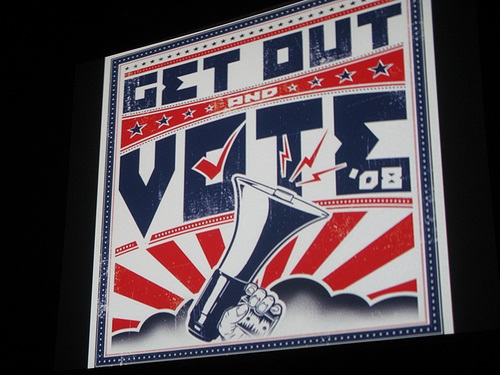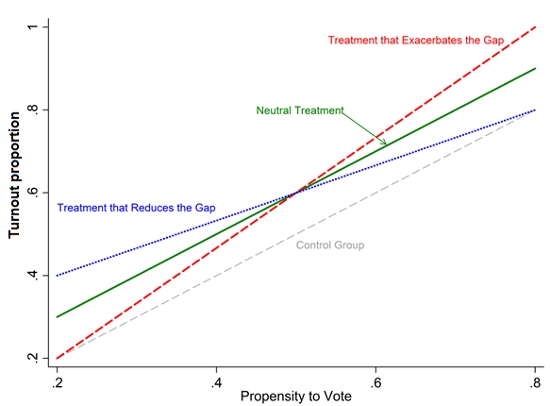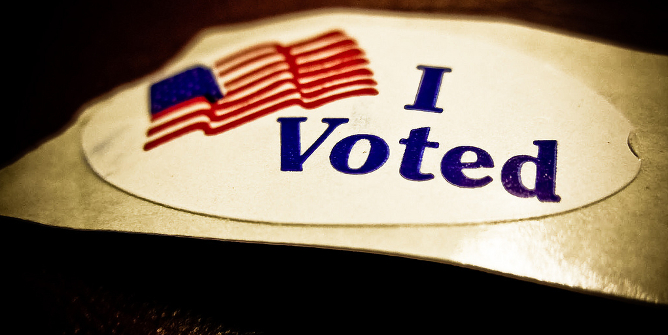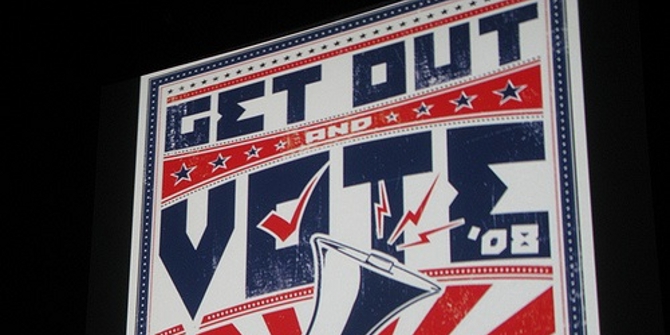
 Get Out the Vote campaigns have become a fixture of campaign season, especially during recent elections, which saw unprecedented organization by both sides to rally potential voters. But are these drives an effective way to close the turnout gap between groups who are already inclined to be involved in politics and those with a lower predilection to vote? Ryan D. Enos and Anthony Fowler examine the effects of Get Out the Vote interventions and find that high propensity voters are more responsive to such initiatives. Rather than closing the turnout gap, they show that such campaigns actually widen this discrepancy.
Get Out the Vote campaigns have become a fixture of campaign season, especially during recent elections, which saw unprecedented organization by both sides to rally potential voters. But are these drives an effective way to close the turnout gap between groups who are already inclined to be involved in politics and those with a lower predilection to vote? Ryan D. Enos and Anthony Fowler examine the effects of Get Out the Vote interventions and find that high propensity voters are more responsive to such initiatives. Rather than closing the turnout gap, they show that such campaigns actually widen this discrepancy.
Political campaigns, drawing on rigorous scientific research, now wage a battle over voter-turnout, enlisting volunteers, staff, and consultants to knock on doors, make phone calls, and send letters encouraging their supporters to vote. The scale of these efforts has exploded in recent elections, with the Obama and Romney campaigns each conducting approximately 200 million of these voter contacts in 2012. In doing so, campaigns are increasing political inequality.
Generally speaking, people that are heavily involved in politics and vote regularly are demographically and ideologically different than people that don’t vote regularly: they are older, whiter, wealthier, and more conservative. Put another way, older, whiter, wealthier, conservative people have a greater “propensity to vote.” These high-propensity types participate more than low-propensity citizens, and we call this difference the “turnout gap.”
A turnout gap can be a problem for a healthy democracy. High propensity voters may become more politically influential than low propensity voters. Indeed, research has shown when the turnout gap shrinks, public policy can dramatically change.

When political scientists and practitioners conduct randomized controlled trials to get out the vote (a.k.a., GOTV), the implicit and sometimes explicit goal is to narrow this turnout gap. Over the past fifteen years, researchers have conducted hundreds of GOTV experiments, identifying the types of mobilization efforts that are the most effective. Campaigns and advocacy groups have quickly adopted these practices, often with the assumption that these methods will close the turnout gap. We can easily see why this assumption is widespread. Perhaps high propensity voters don’t need any further encouragement to vote—they vote anyway—and low propensity voters are more likely to respond to a nudge to go to the polls. But what if these experiments actually do the opposite? What if GOTV methods are more effective for high-propensity citizens than for the underrepresented, low propensity citizens that they are often designed for?
Figure 1 demonstrates different ways in which experiments may theoretically affect the turnout gap. The horizontal axis shows the propensity to vote and vertical axis shows the proportion of voters participating in an election. The three colored lines represent the effects of three hypothetical GOTV interventions, all of which have the same average effect. Each is compared to the control group, the dashed gray line. When a campaign knocks on a door or makes a phone call, which of these changes do you think is most likely to happen? Most people assume that the turnout gap is reduced (the blue line).
Figure 1: Theoretical Effects of Get Out the Vote Interventions on the Voter Turnout Gap

In most cases, this assumption is wrong. As it turns out, GOTV interventions are more likely to increase voting among those that are already more likely to vote, thereby increasing the turnout gap. In a recent study in collaboration with Lynn Vavreck, we collected data from 24 GOTV experiments which, in total, were applied to 1.2 million voters. Each of these experiments had a control and a treatment group. The treatment groups received a door knock, letter, or phone call, while the control groups received no contact. The researchers who had previously conducted these experiments measured, on average, how much more voters in the treatment groups voted than the control group.
However, we did something slightly different: rather than just estimating average effects, we tested for variation across propensity levels. For each of these 1.2 million voters, we constructed a propensity score, indicating how much citizens with similar demographic characteristics are represented among voters and non-voters. As we expected, high propensity voters were generally older, whiter, and wealthier. We then tested whether high-propensity citizens were more affected by the GOTV intervention than those with low propensities. It turns out that high propensity voters are much more likely to respond to the treatment. On average, these experiments widened the turnout gap.
Figures 2 and 3 illustrate our results for one such GOTV experiment, the famous “Neighbors” treatment conducted by Alan Gerber, Don Green, and Chris Larimer. As before, the horizontal axis represents the propensity to vote. In Figure 2, the vertical axis shows the rates of voter turnout for those in the control group (the dashed line) and the treatment group (the red line). As the propensity to vote increases, more people in both treatment and control turnout to vote, but the difference between these lines also increases—that is the turnout gap widening. Figure 3 demonstrates just how much the gap grows. The vertical axis shows the effect of the experiment across different levels of propensity. As you can see, as the turnout propensity increases, so does the strength of the treatment; at high levels of turnout propensity, the treatment effect approaches 12 percentage points, meaning that these high propensity voters are 12 percentage points more likely to vote after receiving the treatment. While at the lowest levels of turnout propensity, the effect is only about 2 percentage points—indicating that the treatments were much more effective high-propensity citizens. Many of the other experiments in our analysis exhibited the exact same pattern, and when we pool data from all experiments, we find strong evidence that, on average, GOTV interventions widen the turnout gap.
Figure 2: Turnout of Treatment and Control Groups across Propensity Levels

Figure 3: Effect of Get Out the Vote Intervention on Voter Turnout across Propensity Levels

When academics or campaigns knock on doors or make phone calls, they are attempting to change who votes and, in many cases, are attempting to decrease political inequality. Our evidence shows that they are actually accomplishing the opposite: the gap between voters and nonvoters increases. Why does this happen? The reasons are likely multifaceted, but the result are similar to what happens in many public policy interventions. Often, interventions designed to decrease inequality have the opposite effect of increasing inequality. For example, take public health interventions in the United States that were aimed at decreasing infant mortality, a problem that especially inflicts poor racial minorities. These policies actually widened the gap in infant mortality between African Americans and whites because infant mortality dropped at a greater rate among whites. This is likely for the simple reason that educated, wealthy people are more likely to receive information and take action in response to public health campaigns. Similarly, we find that higher-propensity citizens are more likely to answer the door or pick up the phone when contacted by campaigners, and if they are contacted, they are more likely to respond to the treatment.
Voter turnout interventions often increase the turnout gap –thereby exacerbating the gap in political power. Does that mean that GOTV campaigns are bad idea? No, not all – as we indicated, increased voter turnout can have important and often beneficial policy implications for reducing inequality. However, academics and political campaigns should examine not just whether their treatment increases voter turnout, but also what it does to the turnout gap.
Please read our comments policy before commenting.
Note: This article gives the views of the author, and not the position of USApp– American Politics and Policy, nor of the London School of Economics.
Shortened URL for this post: http://bit.ly/1o0Xxnt
_________________________________________
 Ryan Enos- Harvard University
Ryan Enos- Harvard University
Ryan D. Enos is an Assistant Professor of Government and Faculty Associate at the Institute for Quantitative Social Science at Harvard University. He researches political psychology and political behavior with a focus on intergroup relations and political participation. His work has recently appeared in the Proceedings of the National Academy of the United States of America and the Journal of Politics.
 Anthony Fowler- University of Chicago
Anthony Fowler- University of Chicago
Anthony Fowler is an Assistant Professor in the Harris School of Public Policy Studies at the University of Chicago. He studies political representation with particular interests in elections and participation. His work has recently appeared in the American Journal of Political Science, Journal of Politics, and Quarterly Journal of Political Science.






